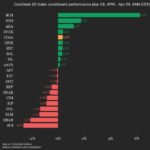On April 14, the cryptocurrency market was shaken up by a startling event involving a massive sell order on Binance, which involved 2,500 bitcoin valued at about $212 million. This sell order was placed at $85,600, slightly above the prevailing market price. This kind of significant sell order typically generates buzz and can influence price movements, and that day was no exception as the market began to gravitate towards this price point.
However, just as traders were eyeing this pivotal moment, the sell order mysteriously vanished from the order book. This sudden disappearance sparked confusion among market participants, leading to a scramble as bulls and bears contended with a sudden lack of liquidity. The atmosphere was already tense due to various geopolitical issues, and the abrupt removal of such a significant order exacerbated the situation, causing bitcoin prices to dip further.
“Manipulative trading behavior is a systemic vulnerability, especially in thin, unregulated markets,” stated Dr. Jan Philipp, a former ECB analyst. “These tactics give sophisticated actors a consistent edge over retail traders.”
This incident raises eyebrows about the possibility of “order spoofing,” a practice defined in the U.S. Dodd-Frank Act as placing a large order with the intention to cancel it before execution. Spoofing can mislead traders, creating a false impression of market strength or weakness. The order appeared to be a strategic move, potentially made during hours when U.S. equity markets were closed—when trading activity was likely lower, making it easier to manipulate prices. Binance has claimed that they are committed to maintaining market integrity and actively monitor suspicious trading practices.
Though the cryptocurrency industry has matured since its early days, instances of spoofing remain a concern. Even with increasing institutional involvement, attempts at manipulation still occasionally surface. For instance, the recent spike in market manipulation attempts highlighted by exchange MEXC signifies that this issue hasn’t evaporated entirely.
“If crypto wants to outgrow its casino phase, we need infrastructure that rewards fair participation, not insider games,” Dr. Jan Philipp concluded, underscoring the need for better regulatory frameworks.
The conversation about spoofing in cryptocurrencies highlights a broader need for improved oversight and stronger mechanisms to protect retail traders. As the landscape continues to evolve, the focus on enforcing fair trading practices is essential in promoting healthy market dynamics.

The Impact of Spoofing on the Bitcoin Market
Insights into the recent events surrounding a $212 million sell order in the Bitcoin market reveal significant implications for traders and the overall market integrity:
- Massive Sell Order:
- A $212 million sell order for 2,500 bitcoin was placed on Binance, influencing market behavior.
- The sell order was removed shortly after, leading to a chaotic moment in trading.
- Market Manipulation Techniques:
- The incident may have involved “order spoofing,” a technique where traders place large orders intending to cancel them before execution.
- This practice can create false signals in the market, leading to volatility and liquidity issues.
- Impact on Traders:
- Retail traders may find themselves at a disadvantage against sophisticated players using spoofing tactics.
- The illusion of market strength can prompt decisions based on misleading information, increasing the risk of financial loss.
- Regulatory Oversight:
- Current regulations are inadequate to effectively monitor and penalize spoofing in the crypto market.
- Experts suggest that robust regulatory frameworks and improved surveillance systems are essential for market integrity.
- Historical Context:
- Spoofing has a history in both crypto and traditional markets, with examples dating back to lows in regulatory oversight.
- Past incidents, such as the 2010 Flash Crash, demonstrate the potential market-wide impacts of manipulative trading practices.
“If crypto wants to outgrow its casino phase, we need infrastructure that rewards fair participation, not insider games.” – Dr. Jan Philipp
These key points underline the necessity for traders, especially retail investors, to remain vigilant, as well as the importance of advocating for better regulatory practices within the evolving crypto landscape.
Market Manipulation in Cryptocurrency: A Closer Look
The recent incident of a massive $212 million sell order disappearing from Binance’s order book has reignited discussions around market manipulation in cryptocurrency trading. This scenario, which caused notable price volatility, highlights both the competitive advantages and disadvantages for traders and platforms involved in crypto markets. The practices seen here, often described as “order spoofing,” present a significant risk to retail traders who may lack the insight or tools to navigate such deceptive tactics effectively.
While the cryptocurrency market has matured, bolstered by institutional participation and heightened scrutiny, the threat of manipulation remains a potent concern. A major advantage for sophisticated traders is their ability to leverage these tactics to influence market direction, potentially reaping substantial profits while leaving retail investors vulnerable to sudden price swings. For instance, the opportunistic placement and quick withdrawal of a large sell order could coax other traders into reactive positions, amplifying market fluctuations that disproportionately affect those less experienced in such tactics.
On the flip side, platforms like Binance tout their commitment to maintaining a fair trading environment, emphasizing the use of advanced surveillance techniques to detect and deter manipulative behavior. This dedication, if truly implemented, serves as a protective layer for the marketplace, enhancing overall trust and potentially attracting a more extensive user base. However, critics argue that the crypto space still operates in a murky regulatory environment compared to traditional financial markets, which could undermine these efforts. This scenario poses significant challenges for retail traders, who could find themselves navigating a landscape fraught with potential pitfalls while simultaneously being encouraged by the promises of a more robust market system.
As more sophisticated trading algorithms and structures emerge, the risk of systemic vulnerabilities increases. As noted by experts like Dr. Jan Philipp from Oak Security, the lack of regulatory oversight in crypto gives a leg up to “smart” traders who exploit these weaknesses. The result could be a wider gap between retail and institutional investors, raising concerns about the fairness of the market overall. With patterns of manipulation being highlighted more frequently, potential investors may be deterred from entering the market altogether, fearing the volatility and unpredictability propelled by these tactics.
In conclusion, the dynamics of market manipulation represent both an exciting challenge and a significant hazard in the evolving crypto landscape. For retail traders, the ability to recognize the signs of such tactics could be the key to navigating market volatility and potentially safeguarding their investments from unscrupulous practices. As exchanges and regulators grapple with these issues, the future of trading transparency in the crypto space remains an ongoing dialogue that could reshape the industry’s trajectory.

















